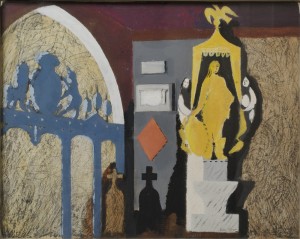The Lieutenant's Lodgings at the Tower of London

Hidden Content, Images, Videos and Documents
“All the time she dwelt in the Tower, if any were sick she made (the prisoners) broths and restoratives with her own hands, visited and took care of them, and provided them all necessaries; if any were afflicted she comforted them, so that they felt not the inconvenience of a prison who were in that place.”
Memoirs of the Life of Colonel Hutchinson
Lucy Hutchinson, 1620-1681
(Recounting the life of her mother, Lucy St.John)
Lucy St.John Apsley, the sister of Sir John St.John, 1st Bt., lived in the Tower from 1617 to 1630; not as a prisoner, but as the wife of Sir Allen Apsley, the Lieutenant of the Tower of London. The above-quote is from a biographical fragment from her daughter Lucy Hutchinson’s "Memoirs", and gives tantalizing glimpses of Lucy St.John’s life within the Tower.
Peeking over the massive curtain walls of the Outer Ward are the gabled roofs of Lucy’s home – a curious juxtaposition of domesticity and fortress.
The house was used for administrative offices too, and as I explored the warren of rooms I came across a small corridor. Just a few feet from Lucy’s front hall, great blocks of stone took over from the domesticity of plaster, and in another pace or two, is the twelfth century Bell Tower. The ambiance is mournful, and it was not at all difficult to think of Thomas More or the young Princess Elizabeth imprisoned in this bleak chamber. Their view from the narrow slit windows was the same as Lucy’s– the execution block.
Traces of Lucy’s life remain within the Tower. She was an herbalist and her medicinals no doubt eased the lives of many of the prisoners she nursed. In another part of the memoirs, her daughter refers to Lucy’s generosity with her hen-house – she allowed Sir Walter Raleigh to make free use of it to conduct his alchemy experiments when he was under her care and lodging in the Bloody Tower. Raleigh was also a great gardener and Lucy paid for his medicinal research so that she might learn from him. The Victorians built over Lucy’s garden, but it is still easy to see the old levels of where her gardens were, and how she would access them from her home. A recent renovation by HRP has installed raised beds containing plants that would have been featured in Lucy and Sir Walter's medicinal garden.
In Lucy’s time, the Liberty of the Tower housed over a thousand families, all of which came under her husband’s jurisdiction. It really was its own small city, for it lay outside of the laws of the City of London (which caused some friction on many occasions). In her time Lucy ministered to the citizens of the Tower as well as the prisoners, walking not just only in the areas where her aristocratic prisoners were lodged, but among the houses and gardens of the residents who all had a home within the Tower of London.
As a footnote, Lucy St.John's daughter, Lucy Hutchinson, was born in the Tower of London. Her husband, Colonel John Hutchinson, the subject of her Memoirs, was imprisoned in the Bloody Tower in 1663 for his purported, but never proven, role in the Farnley Wood Plot against King Charles.
Commentary by Elizabeth St.John
- Year:
- 1600-1700
- Type:
- Building
- Location:
- The Tower of London
- Credit:
- Historic
- Last updated on:
- Tuesday 8th October 2024
